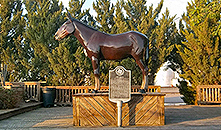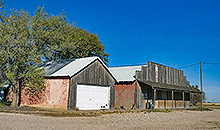Main Menu
Bailey County Data
Bailey County Communities & Places
Genealogy & History Links by USGHN
Important Bailey County Addresses
Sponsors
Bailey County Neighbors
Cochran County, Texas
Curry County, New Mexico
Hockley County, Texas Genealogy & History Network
Lamb County, Texas
Parmer County, Texas
Roosevelt County, New Mexico
Other Websites
Welcome to Bailey County Texas Genealogy & History Network!
Welcome to the Bailey County, Texas Genealogy & History Network. Our purpose is to provide visitors with free resources for genealogical and historical research. To share your genealogy or history information, send an email to txghn@outlook.com and we will happily include it here. For other Texas Counties, visit the Texas Genealogy & History Network state website and go to the appropriate county. Thanks for visiting and good luck with your research! |
|
About Bailey County, Texas...

Bailey County is in the western Panhandle of the state. The most conspicuous topographic feature is a range of sand hills that runs from northeast to southwest a mile south of Muleshoe.
The county was marked off from Bexar County in 1876 and named for Peter J. Bailey, an Alamo hero. Bailey and twenty-one other counties newly formed at the time were attached to Jack County for judicial purposes. In 1881 jurisdiction of Bailey County was transferred from Jack to Baylor County; then, in 1887, to Hale County; and in 1892 to Castro County. Settlement of Bailey County did not come early, since the XIT Ranch held most of its land from 1882 until the division and sale of the ranch in 1901.
The XIT had its origin 1879 when the legislature set aside three million acres in Dallam, Hartley, Oldham, Deaf Smith, Parmer, Lamb, Bailey, Cochran, and Hockley counties to fund the building of the Capitol. Fencing in the county was done between 1883 and 1886, and the first cattle reached the ranch in 1885.  As late as 1900 the United States census counted only four people living in Bailey County.
As late as 1900 the United States census counted only four people living in Bailey County.
The county developed rather quickly during the early twentieth century, however, as old ranchland was divided up and sold to farmers by land developers. Midwestern farmers took special excursion trains to nearby Farwell, then were taken south and shown Bailey County lands selling at ten to twenty dollars an acre. In 1909 the county's first irrigation well was dug. By 1910, seventy-one farms had been established in the county.
A severe drought in 1910 drove away many of these early settlers, but others moved in to take their places. A county seat election was held in 1919, with Muleshoe carrying seventy-four of the 111 votes cast.
During the 1920s and 1930s new conditions helped to transform the county's economy from ranching to  farming. Ground water was discovered at depths of twenty to forty feet, and large ranches were broken up and sold as farm tracts. The expansion of cotton farming continued in the county even during the years of the Great Depression, when cotton farming in other parts of the state suffered severe declines. Though many West Texas counties declined in the years immediately after World War II, Bailey County continued to grow in population until the 1960s.
farming. Ground water was discovered at depths of twenty to forty feet, and large ranches were broken up and sold as farm tracts. The expansion of cotton farming continued in the county even during the years of the Great Depression, when cotton farming in other parts of the state suffered severe declines. Though many West Texas counties declined in the years immediately after World War II, Bailey County continued to grow in population until the 1960s.
In the early 1990s the county had 160,000 acres of irrigated lands and was among the leading counties in agricultural income. It has been said that Bailey County is one of the few areas in the United States that can produce varying crops such as cotton, wheat, corn, grain, sorghums, soybeans, castor beans, hay, peanuts, cabbage, lettuce, peas, and beans.
Muleshoe, the largest town in the county, hosts the Mule Days festival each August and the county fair every September.
 The county has a total area of 827 square miles, of which 826 square miles is land and 1 square mile (0.1%) is water. The population recorded in the 1900 Federal Census was 4. The population peaked in 1960 at 9,090. The 2010 census recorded 7,165 residents there.
The county has a total area of 827 square miles, of which 826 square miles is land and 1 square mile (0.1%) is water. The population recorded in the 1900 Federal Census was 4. The population peaked in 1960 at 9,090. The 2010 census recorded 7,165 residents there.
Neighboring counties are Parmer County, Texas (north), Lamb County, Texas (east), Hockley County, Texas (southeast), Cochran County, Texas (south), Roosevelt County, New Mexico (west), and Curry County, New Mexico (northwest). The county seat is Muleshoe. Other communities in the county include Bula, Enochs, Maple, Needmore, and Virginia City.
Bailey County, Texas Records
Birth Records - The Texas Department of State Health Services has records from 1903 to present. Records for the last 75 years considered private and will only be provided to certain individuals. To obtain current information on who may obtain a record, how to submit a request and an official request form, see the Texas Department of State Health Services website or write to Texas Vital Records, Department of State Health Services, P.O. Box 12040, Austin, TX 78711-2040.
For older birth records you will have to write to the County Clerk of the applicable county. The existence of birth records prior to 1903 will vary widely from county to county. Local historical societies and genealogy collections in local libraries may be able to provide some information.
Death Records - The Texas Department of State Health Services has records from 1903 to present. Records for the last 25 years considered private and will only be provided to certain individuals. To obtain current information on who may obtain a record, how to submit a request and an official request form, see the Texas Department of State Health Services website or write to Texas Vital Records, Department of State Health Services, P.O. Box 12040, Austin, TX 78711-2040.
Marriage Records - The Texas Department of State Health Services can provide a verification letter of marriage for Texas marriages from 1966 to present. This is NOT a marriage license. To obtain a certified copy of a marriage license you must contact the County or District Clerk in the county or district where the marriage took place.
Local historical societies and genealogy collections in local libraries may be able to provide some information.
Divorce Records - The Texas Department of State Health Services can provide a verification letter of divorce for Texas divorces from 1968 to present. This is NOT a copy of the divorce decree. To obtain a certified copy of a copy of the divorce decree you must contact the County or District Clerk in the county or district where the divorce took place.
Local historical societies and genealogy collections in local libraries may be able to provide some information.




